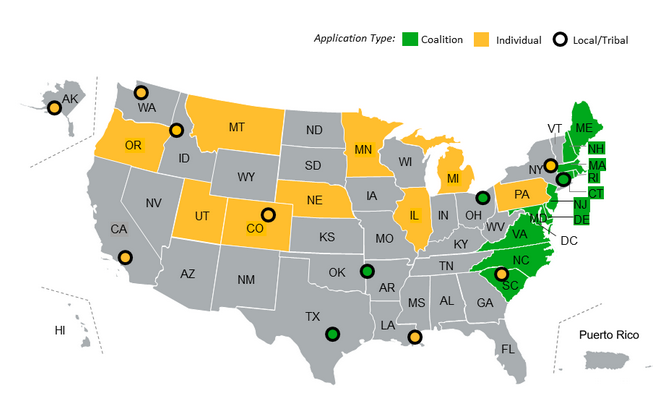

By Erin Cosgrove | Tue, August 27, 24
In July, the US Environmental Protection Agency (EPA) announced winners of the Climate Pollution Reduction (CPRG) implementation grants, which will award $4.3 billion to states, metropolitan areas, and tribal governments across the country. The NEEP region had six selected applications, totaling about $1.5 billion. Four of the awards were coalition-based, harnessing the power of regional collaboration. States were the lead applicants for four projects, with municipalities receiving two projects. Building decarbonization is also taking center stage, with one of the largest dollar amounts going to a New England residential heat pump accelerator. Other applicants prioritized electric power generation projects, transportation decarbonization, industrial decarbonization, waste management, and conservation of agriculture and natural lands.
This blog provides an overview of the CPRG implementation grant winners, a summary of the NEEP region’s winning applications, and key themes around workforce development and reaching underserved communities.
What Are CPRG Implementation Grants
The EPA’s Climate Pollution Reduction Grants Program provides nearly $5 billion in grants to states, local governments, tribes, and territories to develop and implement plans for reducing greenhouse gas emissions and other air pollutants. The program occurs in two parts: $250 million for noncompetitive planning grants and $4.6 billion for competitive implementation grants. In March of 2024, states submitted priority climate action plans (PCAPs), which outlined priority measures to help states reduce greenhouse gas emissions. States were then able to compete for an implementation grant to execute one or many of the measures outlined in their PCAPs
Below is a snapshot of the winners:
Twenty-five applications were selected to receive $4.3 billion of the competitive implementation grants, with funding amounts ranging from nearly $3 to $500 million. Thirteen of the selected grants will flow to states, 11 to municipalities, and one to a tribe. (The EPA will announce winners for a separate tribes and territories competition later). Of the 25 applications selected, eight are coalition-based, involving various combinations of states and municipalities. The projects represent a variety of approaches to reduce carbon pollution with each state outlining a different priority. The priority that appeared in the most projects was building decarbonization (15 projects) followed by measures to reduce emissions in the power sector (13 projects), transportation (11 projects), agricultural and natural lands (10 projects), industrial sector (seven projects), and waste management (six projects).
What We Are Excited About
The projects selected across the Northeast and Mid-Atlantic highlight important themes that show alignment on common priorities and policies. These include building decarbonization, equity, workforce, regional coordination, and market transformation. Here is a preview of how each of these topics appeared in applications.
- Building Decarbonization: Building decarbonization is important because building emissions are one of the main contributors to climate change in our region, contributing to high levels of air pollution and greenhouse gas emissions. In New England especially, households face high energy bills due to expensive heating fuels and inefficient systems. Efficient all-electric technologies are just starting to become more widely available for commercial buildings. CPRG projects have prioritized investment in cold climate heat pumps and geothermal technology, and are looking to engage new parts of the market to achieve building decarbonization goals, such as through a mid-stream heat pump program that takes a new approach to incentives and engages with distributors and contractors to increase adoption.
- Equity-Based Initiatives: Every project in the region prioritized low-income and disadvantaged communities (LIDACs) through approaches such as direct investment, engagement with community members, and investing in new programs and strategies. Projects were focused on providing benefits at the community live and identifying replicable solutions. Most applications proposed investing in an equitable workforce, by providing enhanced workforce training and business growth opportunities to ensure a direct path to high-quality employment for individuals who are interested in the field.
- Workforce Training and Growth: Every building decarbonization- and market transformation-focused CPRG award in the region emphasized the need for workforce training to address gaps in our industry. Combining projects with training will ensure that the workforce is ready to implement upcoming projects and build capacity to support future projects. Regionally-based programs can work together to adopt similar standards and certifications at the state level, enabling contractors to work in different states, thereby expanding the pool of qualified contractors.
- Regional Coordination and Expansion: Coalitions formed for CPRG implementation serve as examples for how states and municipalities across a region can come together to implement a program. Collaboration across state lines can unlock economies of scale and allow easier replication of programs. Additionally, regional workforce programs can provide opportunities for businesses to expand and work across state lines, while ensuring there is a baseline of training and certification.
- Investment In Market Transformation Efforts: CPRG funding will be deployed to implement new programs that have not been seen at scale in our region before, including industrial building and commercial trucking decarbonization programs that look to establish a charging network. These programs look to overcome market barriers that prevent or slow the adoption of energy efficient technologies. Once complete, these projects can be replicated and scaled throughout the nation.
Regional Projects Snapshot
Here’s a preview of what the region can expect to see from CPRG funding in 2025 and beyond.
Connecticut, New England Heat Pump Accelerator, $450 million
The New England Heat Pump Accelerator is a coalition between Connecticut, Maine, Massachusetts, New Hampshire, and Rhode Island. The Accelerator will rapidly accelerate the adoption of cold-climate heat pumps and heat pump water heaters in single- and multi-family buildings across New England through a regional effort. The project has three pillars: midstream rebates, grants for LIDACs, and a workforce and consumer resource hub. Midstream rebates will engage distributors and contractors to scale the adoption of heat pumps and activate the full industry supply chain (manufacturers, distributors, and contactors). The resource hub will provide workforce training and informational materials on heat pump installation, sizing, and operation. The grants will focus on addressing barriers and finding scalable solutions to adoption in LIDACs.
Pennsylvania, Reducing Industrial Sector Emissions in Pennsylvania (RISE-PA), $396 million
The RISE-PA project will allow Pennsylvania to tackle industrial decarbonization. RISE-PA will reduce greenhouse gas emissions in the industrial sector through a competitive grants program and incentives for small-, medium-, and large-scale decarbonization projects across the state. Projects will leverage private capital and provide replicable and scalable solutions in the hard-to-reach industrial sector. RISE-PA will also create high-quality jobs and apprenticeships to help meet the market demand, including prioritizing and investing in equitable workforce development activities. Lowering emissions at industrial facilities can also improve air quality in LIDAC communities by reducing hazardous air pollutants, toxins, and other harmful substances.
New Jersey, Clean Corridor Coalition: A Proposal for ZE-MHDV Infrastructure Along the I-95 Corridor, $248 million
The Clean Corridor Coalition is a coalition between New Jersey, Connecticut, Maryland, and Delaware to tackle heavy-duty vehicle charging. The Clean Corridor coalition will deploy commercial medium- and heavy- duty electric vehicle charging infrastructure on the Interstate-95 freight corridor as a joint venture. This program also seeks to tackle this difficult-to-decarbonize sector through investing in workforce training. The program aims to train 400 workers in the construction, operation, and maintenance of heavy-duty vehicles infrastructure. It will also create opportunities for low-income and disadvantaged community members to receive specialized workforce training with a direct path towards high-quality employment.
City of New Haven, CT, Union Station Area Thermal Energy Network, $9 million
The Union State Thermal Energy Network is a coalition between the New Haven Office of Climate & Sustainability, New Haven Parking Authority, and Housing Authority of New Haven. The grant will fund a networked geothermal system to provide heating and cooling to Union Station, a historic rail station, and provide low-cost, renewable energy for up to 1,000 mixed-income housing units in the area. The grant will eliminate the use of on-site fossil fuels from new properties and provide an electric capacity resource in the form of grid interactivity, demand management, and thermal energy storage. It will also invest in workforce development, creating job- and hands-on apprenticeship opportunities for individuals in underserved areas.
Hudson Valley Regional Council, Mid-Hudson Municipal Landfill Emissions Mitigation, $3 million
Hudson Valley Regional Council’s Mid-Hudson Municipal Landfill Emissions Mitigation program will fund measures to reduce fugitive methane emissions from closed landfills through biofilters. Landfills are the largest source of emissions in New York’s waste sector. When organic material breaks down, they can release GHG emissions for up to 20 years. Municipal landfills have gas collection systems in place to reduce emissions. The selected application will fund more gas-collection systems to reduce emissions from landfills, provide technical assistance for communities to install solar arrays and battery storage systems, and support ecological restoration through installation of native pollinator gardens. Nearly half of the proposed projects will be in LIDACs, helping to reduce emissions in these communities.
North Carolina, The Atlantic Conservation Coalition, $421 million
This project is a coalition between Maryland (a NEEP-region state), North Carolina, South Carolina, and Virginia. It will protect and restore coastal habitats, peatlands and forested land through promotion of coastal resilience and sustainable forestry management practices across the states. The grant will fund 21 implementation-ready projects that will benefit LIDACs across a range of coastal areas, tribal communities, and rural communities. Protection of these natural resources can provide public health benefits to LIDAC communities, as they can increase access to local foods and improve recreational water quality. These projects will also reduce the risk of flooding, wildfire, and extreme heat that disproportionately impacts vulnerable communities throughout the region.
Conclusion
NEEP congratulates all the New England and Mid-Atlantic states, metropolitan areas, and tribal governments on their winning applications under EPA’s CPRG program. These grants will lay the foundation for new strategies to change how we address decarbonization across all sectors including buildings, industrial applications, decarbonization of the gas system, and waste. Each project is also committed to Justice40 and investing in community-level solutions. By investing directly in communities, programs can begin to tackle barriers that prevent all residents from seeing the benefits of decarbonizing our homes and buildings.
There is still more to do with CPRG. States have developed Priority Climate Action Plans and will be designing Comprehensive Climate Action Plans later this year and into 2025. NEEP is excited to see states implement these plans and design their final climate action plans in the coming year.

